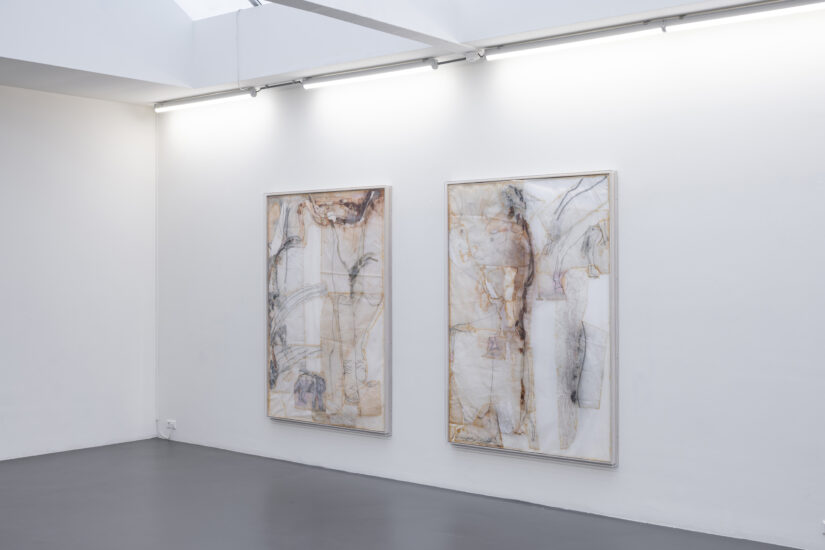Jo Baer in conversation with philosopher Jan Bor on art and philosophy

Jo┬ĀBaer & philosopher Jan Bor will discuss the imagination of thinking, and vice versa – thinking┬Āabout the imagination.
Held amidst her solo exhibition, ŌĆśBetween the Lines (R.A.T.S. however…)ŌĆÖ, 94-year-old American visual┬Āartist Jo Baer will enter into conversation with the Dutch philosopher Jan Bor, author of ŌĆśWaarnemenŌĆÖ(ŌĆśPerceptionŌĆÖ), recently published by Prometheus Books. The meeting will be introduced by philosopher
Floris van der Burg and ┬Āart historian┬ĀJanine Armin, PhD candidate at the University of Amsterdam, on BaerŌĆÖs work.
The central question is how and why art can develop from figuration to abstraction and sometimes, as in┬Āthe case of Baer, the other way around. How can the interaction between the observer and the observed┬Ābe interpreted? How can absence be made visible? How can we relate to the unspoken layers of our┬Āperception? The conversation will focus on the transformation of what you see, what you sense, what is┬Āactually there, and what it is like for an artist to navigate the ever-unlimited space and potential of viewing.
Jo Baer (1929) has explored various media and styles in her long career. After working briefly with an abstract expressionist idiom, she positioned herself as a minimalist artist in the 1960s, contributing to the development of hard-edge painting. With her departure to Ireland in 1975, when her career was at its peak, her work also changed. She developed her so-called ŌĆśradical figurationŌĆÖ, or ŌĆśimage worksŌĆÖ in which she rendered recognizable forms partially or layered, and which she continued in Amsterdam where she has lived and worked since the mid-1980s.
This figurative vocabulary enabled her to better convey meanings ŌĆō albeit without becoming truly concrete. Baer’s work thus focuses on formal strategies, the use of materials and the viewing experience, as well as various, sometimes disguised, recurring thematic aspects. The mutual connections between the works gradually reveal themselves and are emphasized by an ever-changing, expanding arrangement.
The intuitively composed constellations of sometimes suggestive and other times more specific shapes in her prints, drawing and paintings go beyond an unambiguous story. Instead, in relation to each other, they have the subtle, emotional effect of a poem: ŌĆ£The meaning is incorporated in the whole. I choose things and I structure them to get new meanings. I am leaving it for anyone to construct the painting. It is semi-structured. Loose ends, I like thatŌĆ”ŌĆØ
Jan Bor (1946) is a philosopher that regularly writes about art. He has taught at a wide range of universities and art schools. He obtained his PhD in 1990 for a thesis on the French philosopher Henri Bergson with ‘Bergson and Immediate Experience’. He later published, among others, ‘De Verbeelding van het Denken’ (of which more than 100,00 copies were sold), ‘A New History of Philosophy’, ‘What is Wisdom?’, ‘Modern Modern’, ‘Mondriaan Filosoof’, ’25 Centuries of Eastern Philosophy’ and ‘OnZen’. In his latest book ŌĆśWaarnemenŌĆÖ (ŌĆśPerception’) at Promotheus Books, he examines the relationship between art and philosophy.
Emptiness & Infinite Space IX is an initiative of Wim de Haan Foundation, organized in collaboration with Rozenstraat – a rose is a rose is a rose.
Emptiness & Infinite Space IX is an initiative of Wim de Haan Foundation and the 9th edition is organized in collaboration with Rozenstraat – a rose is a rose is a rose.
Admission if free.
Please register via info@rozenstraat.com
Wim de Haan Foundation supports contemporary artists and organizes art initiatives in the spirit of Amsterdam-based artist Wim de Haan (1913-1967). De HaanŌĆÖs work arose from experiences of loneliness and feelings of emptiness following a period of captivity in a Japanese concentration camp during World War II. For De Haan, the depth of this emptiness also sparked a profound realization of the infinite mutability of life. In klight of this, the Foundation has organized eight symposia since 2017 under the title ├ēmptiness & Infinite SpaceŌĆÖ. Within this series, philosophers and artists come together in conversation to explore the boundaries of their field of work and simultaneously bridge beyond them into an intermediate zone of mutual understanding.